The Silence of the LLAMS
Human Rights Violations in Germany
Introduction
Human rights abuses in Germany are perpetrated at low level. "Low Level"
in this context does not mean diminished ferocity but rather reduced visibility. For that reason
the violations go largely unnoticed by watch organizations. The nature of the abuses is also
somewhat different to older notions of the "pulled-out fingernails". This paper shows
some such violations in live cases and finishes by considering the implications of the virtual
abolition on 14.10.2004 of the European Convention for Human Rights and Basic Freedoms in Germany,
which up to now has in any case been 'more honored in the breech than in the observance'.
The following links are provided for convenience:
The LLAMS-Model
The
LLAMS-Model: A Packet of Abuses
 There is ample evidence
of systematic human rights abuses having been perpetrated in West Germany ( now the re-unified
Federal Republic ) during the post-war occupation and thereafter. This went largely unnoticed
even by the western powers, mainly because the abuses were surreptitious and well camouflaged,
kept at low level, "under the radar" of the watch organizations.
There is ample evidence
of systematic human rights abuses having been perpetrated in West Germany ( now the re-unified
Federal Republic ) during the post-war occupation and thereafter. This went largely unnoticed
even by the western powers, mainly because the abuses were surreptitious and well camouflaged,
kept at low level, "under the radar" of the watch organizations.
The LLAMS ( Low Level Abuse Model ) Model has three major organisational
components, Administration, Justice and Industry. The perpetrated abuses take place mostly
at municipal level, where they are best organised and easiest to conceal. Certainly nobody
would seriously go looking for pulled-out finger nails and cigarette burns in Germany in 2005.
Closer scrutiny, however, reveals multiple structure systems capable of extreme viciousness
against selected victims and their families. Because all three organisations are controlled
by the extraneous structures of local government ( the municipalities in Germany are thoroughly
corrupt with the asynchronous form of corruption known as "Vetternwirtschaft" or
"Brotherhood Economies") , a frontal attack on individuals and their families can
be conducted using all three elements to make up a packet of abuses, which is known as the
"Total Sociological Attack (TSA)" and is mostly characterized by an almost unbelievable
viciousness.
The way in which the LLAMS works in the Justice System was described by "Attorney X"
in a letter to the author on 11.01.2001. What "Attorney X" said about freedom of
speech in Germany is very revealing:
|
In the verdicts of the lower courts, the citizen catches it in the neck, every time
he expresses himself in any forceful or drastic way. These subordinate courts do not
take any notice whatsoever of the verdicts of the supreme constitutional court. They
know that the constitutional court is practically out of reach for the normal citizen.
It could take about 5 years just for him to get a hearing."
|
The LLAMS is only known for sure in Germany. However, glimpses of similar manifestations
in France and the United Kingdom, but reduced in scale, have been noted. A detailed description
of the Model is at present in restricted circulation. At the time of writing it is not known
when the Model can be generally released.
1. Live Cases of Human Rights Abuses
Dissident Helmut Palmer
|
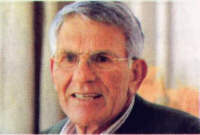
|
|
Dissident Helmut Palmer |
Helmut Palmer died on 24.12.2004 of cancer. He was a well-known dissident of
mixed Aryan and Jewish parentage propagating anti-authoritarian politics. Palmer was very direct,
always calling a spade a spade and not for instance a "top-soil relocation device".
In one case he opined that a local politician was "about as suitable for a political career
as a hedgehog is for wiping one's behind". It is hard to imagine, however, any adult person
being seriously bothered by Palmer's brand of "poetry". On the contrary, Palmer was
a very gifted orator, who was able to enchant his audiences with the skillful use of his local
dialect.
The statistics in Fig A1 showing Palmers convictions for 'insult' demonstrate
just how much maturity exists in public life in Germany today and just to what measure the
shadow of dictatorship still hangs over that country.
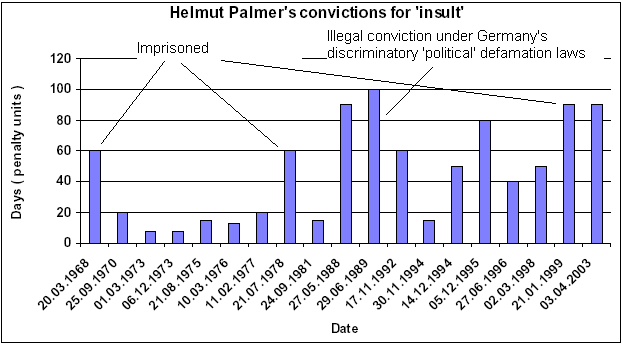
Fig A1. Helmut Palmer's Convictions for 'Insult' since 1968. The
three terms of imprisonment have been converted to fictional day-units
for the sake of comparison.
Palmer thought that the violations of his human rights were indicative of still present Nazism
in the system. At the time of his first conviction and prison sentence, according to the Free
University of Berlin, about 70% of the judges of West Germany's higher courts had been the
perpetrators in Hitler's judicial murder system ( 5,500 arbitrary executions by the notorious
Volksgerichtshof and over 22,000 military executions during WWII compared to 146 military executions
in the combined French, British and American Forces. No former Nazi judiciary was ever prosecuted
for these crimes in post-war Germany ). By 1985 these creatures would have disappeared from
the scene. The profile of Palmer's persecution, however, shows no sign of a let-up in the abuses
after 1985. The trend shows rather a small jump in ferocity after 1988. If Palmer had been
right, then the Nazi ethos would seem to have an extraordinarily high persistence or an infinite
"Radiation Half Life". On the other hand, it could be a blind alley leading to erroneous
conclusions. A resolution of this question will, therefore, have to be left to properly qualified
specialists.
Nazi justice or not, the convictions are a damning indictment of post-war German Justice as
well as the infantile and simplistic mentality still widespread in German public life. The
memorandum of the Organanization for Security and Cooperation in Europe volume 35 No 12 of
May 24, 2002 contains the following statement:
|
Criminal defamation and "insult" laws are often defended as necessary
to prevent alleged abuses of freedom of expression. They are not, however, consistent
with OSCE norms and their use constitutes an infringement on the fundamental right
to free speech. |
The scorn of the OSCE members for Germany with its backward 'insult' laws seems to have escaped
the notice of the leadership here. The same hardness of hearing was demonstrated by Palmer's
conviction in 1989 for 'insult' under Germany's infamous former Paragraph 185a, which prescribed
additional penalties for the 'insult' of a person in political life and was a substantial contempt
of the European Court of Human Rights, which forbade such discrimination in its judgement in
the case Lingens v. The Republic of Austria in 1986. Since then this Paragraph has been replaced
by Paragraph 188 which prescribes additional penalties for the libel or slander of 'politicians'.
A comparison here with the ridiculous but nevertheless vicious "Arian" Paragraphs
which came from the Nuremberg rallies in the 1930s and the equally preposterous notion of the
existence of a "Master Race" is not inappropriate.
The profile of the convictions show no sign of the principle of escalation, i.e. stiffer
penalties for repetition of offences. They wander up and down inside the envelope where they
would not be conspicuous. This is just another mark of the complete lack of credibility of
the German criminal justice system.
The Model "Alice in Heidelberg"
The generic abuse model "Alice in Heidelberg" is directly derived the real case
described here (11 Cs 12 Js 22734/ 02-AK 677/03 ) in which the Justice authorities of Heidelberg,
represented by District Attorney Peter Wechsung, local judge Olbrich and Justice
Mühlhoff of the District Court, participated. The name was inspired by the fictional
court in "Alice in Wonderland" in which the principle "First the sentence
then the verdict !" ( the Queen of Hearts ) came into use.
The model "Alice" itself is a generic cocktail of certain types of human
rights abuses in the criminal justice system and is widely employed by the justice authorities
throughout the Federal Republic. It can be best understood using the diagram in the file below:
Download the model "Alice
in Heidelberg" as pdf-file
An essential part of the model is the use of the Summary Penalty Order (SPO,
"Strafbefehl") which is a method of pushing human rights abuses through in secret.
There is no public hearing. Although the accused has the right to refuse the SPO, it is a court
verdict signed by a judge. The SPO can result in a registered conviction and would therefore
not be comparable to a parking ticket. Should the accused be on vacation for two weeks then
on return he or she could have a previous conviction.
Steps 1-3,4-8 and 11 of the Model were used against Mrs. Egbers resulting in
a conviction and a fine of 1,800 EUR
As in very many cases, the story begins with criticism, in this case of an attorney
with good connections to the justice authorities. The Attorney, a Dr. Peter Hausen from Ebersbach,
received a satirical certificate ( "Contra Legem" )
from the Association of Victims of Justice in Koblenz (JOB). The certificate says that "were
the abuse of the legal process to be made an Olympic event, then Hausen would be in line for
a gold medal". A covering letter accused Hausen of representing both sides in a divorce
case.
Hausen suspected a certain Mrs Annerose Egbers of JOB had been the sender of the
certificate and went to the District Attorney's office in Heidelberg on 12.11.2002 with a formal
legal complaint of 'insult' against Egbers. As evidence he
offered plenty of indignation but was very careful to avoid saying that he did not represent
both sides in a divorce case. For this there may be good reason: According to Egbers a judge
in the said divorce case had rebuked Hausen for the same irregularity. The District Attorney
Peter Wechsung, apparently decided that Hausen's indignation would be admissible evidence without
asking him the difficult question. His calculation turned out to be right because Local judge
Olbrich was also prepared to convict on the basis of indignation - but no evidence.
|
1. DA's office Heidelberg instituted an 'investigation' into Hausen's complaint
and conducted it in the quality to be expected in this part of the world.
|
|
2. No proof could be found that Mrs. Egbers had sent the certificate to poor Dr.
Hausen, so Wechsung decided to apply for a search warrant ( sic ! ) to
see if anything incriminating could be found in Egber's flat. What Wechsung thought
he would find is a matter of speculation. Commensurate with his otherwise immature
behavior he could have been looking for wooden spoons, hard-boiled eggs or old onions
for fear that he himself might be in line for a prize from the JOB activists.
|
|
3. Local judge Hasdenteufel of Lahnstein thought that the indignation of poor Hausen
was just right . Just as indignant Hasdenteufel approved Wechsungs Onion-Quest and
issued a search warrant on 28.05.2003.
|
|
4. Despite all the stamps and coats-of-arms on the paperwork, no "onions"
could be found in Egber's flat. However, Wechsung not really needing evidence anyway.
He sent a "Strafbefehl" (SPO, see diagram ) to judge Olbrich in the
local court of Heidelberg. Olbrich in common with his colleague Hasdenteufel saw
another historic chance to uphold the standards German Justice and keep criticism at
bay. Olbrich signed the SPO on 24.11.2003. Here it should be mentioned that Olbrich
is also known in other interesting respects. Recently, he was involved in an ugly case
of mobbing of an employee of the court, for which he enlisted the support of a Professor
Stefan Biedert, Psychiatrist and spouse of Judge Mrs. Biedert of the same court
( See also below ). Mrs Biedert runs a kind of procurement agency at her place of work
for her husband. ( They think such things are OK in Germany ).
|
True to the "Alice" model local Judge Olbrich approved the illegal SPO on 24.11.2003
and imposed a fine of 90 days pay, which carries also the stigma of a centrally recorded conviction
in Germany. Mrs. Egbers formally objected to the SPO which caused Olbrich to plan a hearing
for 18.02.2004. Olbrich decided also to make use of the psychiatric procurement agency at his
disposal and got Judge Mrs. Biedert to task her husband with psychiatric examination of Mrs.
Egbers. As it happened Mrs. Egbers was ill on the day and could not attend the hearing. Although
the accused produced a medical certificate Olbrich decided that it was not in order ( without
ringing Mrs. Egber's general practitioner, of course ). In the absence of the accused, Olbrich
seized the golden opportunity to legalize all the perversions and declared the SPO to be final.
The Olbrich, Biedert and Biedert Psychiatric Service did not of course get to the lucrative
core of the business on 18.02.2004. However, as a consolation prize, Wechsung stuck 148,00
EUR onto the court costs to help stock up the poor professor's pocket money. Perhaps Judge
Mrs. Biedert will at least get a percentage of the somewhat diminished profit.
Mrs. Egbers complained to the district court ( Judge Mühlhoff ) among other things
about the violations of the European Convention for Human Rights and received the usual pseudo-judicial
verisimilitude in reply. Mühlhoff studiously avoided referring to the complaint about
the violations of European Law in his judgement. The author, needing to clarify this point,
rang Mühlhoff on 04.08.2004. The conversation is recorded in the attached memorandum which
also went to Mühlhoff. Page three contains the English version. Mühlhoff managed
to express succinctly what he and his colleagues throughout the Federal Republic think of European
Law.
Telelcon Briody/ Mühlhoff
04.08.2004
Dr. Brosa and the 'Modersohn Alternatives'
|
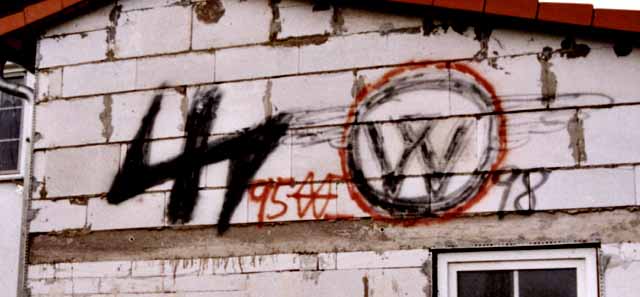
|
|
The House in Kirchhain with Nazi symbols (1 metre high approx. ), which
two Police Lieutenants could not find - in their own precinct and which is not far
from judge Laudis office. |
The house in the picture shows symbols of old and new Nazism. From left to right: The 'Wolfsangel'
( the symbol of the 2. SS-Tank-Division, which perpetrated the massacre of Oradour-sur-Glane
in 1944 - with particular savagery ) and frequently used by neo Nazis today, '95' ( unknown,
but maybe the year of the Oklahoma bombing), '88' ( code for 'Heil Hitler' ), the Symbol 'W'
( used both by neo Nazi movements and the 'White Church of the Creation' - now Creativity Movement
- in the USA, a vicious white supremacy movement whose modus operandi includes murder ) and
'98'(unknown). The Symbols are all painted in the colors of the Third Reich. As far as can
be determined the State of Hessen, which includes Kirchhain is the biggest hot-bed of Nazism
in the Federal Republic of Germany, and is also home to Martin Hohmann the Member of Parliament
who delivered the Infamous "Perpetrator Race" speech. Hohmann was expelled from the
CDU only because of exposure of the offences in the USA, otherwise he would still be gracing
the Christian Democrats with his presence. It should, therefore, surprise no-one, that in this
environment the Symbols on the house had been on public display for over five years before
being brought to public attention by a Dr. Ulrich Brosa from Amöneburg ( Hessen ) and
Irmela Mensah-Schramm from Berlin. Brosa and the Ant-Racial Telephone Service Marburg submitted
criminal complaints in the spring of 2003.
The subsequent investigation by the Police Authorities in Hessen was evaluated by the Author
using the investigation standards of the Royal Air Force. The evaluation report ( German )
can be downloaded under:
By way of comparison, an investigation report of the business crime department in Tübingen
was evaluated using the same standards. In Summary the results of the main items were:
|
Topic
|
Marburg |
Remarks |
Tübingen |
Remarks |
|
1. Did the investigating officer evaluate and understand the task-sheet ? |
No |
The task sheet of the DA's office in Marburg was of extremely poor and superficial
quality. The investigating officer should have tried to clarify this.
|
Yes |
|
|
1. Was there a contents list ?
|
No |
|
Yes |
|
|
2. Was there a list of relevant and discarded enclosures ?
|
No |
|
Yes |
|
|
3. Was there an investigators diary ?
|
No |
|
Yes |
|
|
4. Was there a Narrative of events ?
|
No |
|
Yes |
|
|
5. Were accruing conflicts of evidence resolved ?
|
No |
Several major contradictions were ignored |
N/A |
|
|
6. Was there a systematic approach for interrogating witnesses ?
|
No |
The investigation was conducted without any system. |
Yes |
|
|
7. Was evidence from witnesses correctly adduced ? |
No |
Especially the house owner's self-contradictory statements were not followed up.
|
Yes |
|
|
8. Were all key Witnesses interrogated ? |
No |
Neither the house owner's girlfriend nor Dr. Brosa were interviewed. After the police
investigation had been concluded the DA's office in Marburg decided to interrogate
Irmela Mensah-Schramm.
|
Yes |
|
|
9. Were the conclusions of the investigation based on the adduced evidence ? |
No |
All questions which could have led to a clarification were omitted |
Yes |
|
|
10. Was any form of progress reporting or consultation with the tasking authority
conducted ? |
No |
There was virtually no task leadership exerted by the DA's office in Marburg. The
investigating officer should have asked for more clarifications from the DA. |
No |
This investigation was conducted under the very weak leadership of the DA's office
in Tübingen. However the investigating officer could have done more to ask for
progress meetings.
|
Whilst there is as yet no standardized marking system, the Hessen Police would get about 3%
of the marks and the Tübingen Police ( Chief Inspector Turski ) about 95% ( with the reservation
under point 10, this was excellent work by Turski ). The witness-interrogation by the Berlin
Police ( Chief Inspector Ms. Lewert ) was in contrast to the poor quality produced by the Hessen
Police very convincing. In standard German performance ranking (1- 6) , Chief Inspectors Turski
and Ms Lewert would receive a '1' and the Marburg Police a '6'. ( A '6' is as bad as it can
get .)
The reason for including the work of the Tübingen Police here demonstrates that the
author is not an unreasonable perfectionist and that the standards of Royal Air Force Investigations,
which he applied for the evaluation here, are also practiced in Germany by some authorities.
There is a built-in dilemma in the evaluation of the
work of German Justice Authorities, which was expressed in the world-wide acclaimed novel by
Hans Helmut Kirst "Officer Factory". After listening to the verbal report of "Oberkriegsgerichtsrat"
( military judge third level ) Wirrmann on the investigation into a murder, General Modersohn
remarked,
|

|
"If you really believe what you are telling me then you are incompetent.
If on the other hand you are just pretending to believe it, then I must regard you
as a liar."
Thomas Holtzmann as Gen. Modersohn in the film version of "Officer
Factory". Mondada Films Inc 1988 |
Whilst "Officer Factory" is a novel, it is based on Kirst's own experiences as a
professional soldier ( and one-time instructor in an officer school ) of the Wehrmacht during
WWII. Kirst was an acutely accurate observer who was able to dig deep into the psyche of the
characters he was portraying. For that reason his novels contain very many useful models of
behavior. The investigation by Wirrmann shows the typical characteristics of many of the so-called
investigations by very many DA's offices in Germany today. Logically, the 'Modersohn Alternatives'
always lead to the same result. Modersohn in the novel thus made no attempt to determine which
of the two possibilities had been true, because he was only interested in the outcome.
From the international point of view it is also not necessary to resolve the question because
the responsible heads, Hessen Justice Minster Wagner, Hessen Minister of the Interior Bouffier
and Hessen Attorney-General Anders were all fully informed. It had been their responsibility
to resolve the matter but in the end the guilty party is the Federal Republic of Germany which
allowed these repugnant Nazi Symbols to be displayed for over 5 years on a house in Hessen.
Whether this was through criminal behavior of the Hessen authorities or just sheer incompetence
is of no interest to the international community - only the result matters.
|
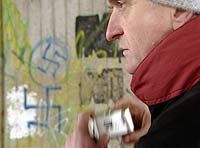
|
|
Anti-Nazi Dr. Ulrich Brosa photographing inflammatory Nazi graffiti
at a public place |
For many types of NGO in Germany a resolution of the Modersohn Alternatives is important.
For example one of the three who submitted criminal complaints about the Nazi Symbols on Display
in Kirchhain, Dr. Ulrich Brosa, an anti-Nazi, certainly has an interest in knowing whether
or not the Marburg Police had deliberately and criminally covered up the 'Wolfsangel'-affair
( as evaluated by the author above ). Brosa obtained a copy of the investigation file early
in 2004 and submitted a complaint against the three police Lieutenants. Details of the actions
of the three policemen ( anonymized for future instructional purposes ) are included in the
Evaluation.
According to the DA's office in Marburg, a complaint from Brosa dated 04.02.2004 went to
Minister of the Interior Bouffier. The DA's office - represented by the same individual who
had misdirected the investigation in the first place - drafted a charge against Brosa alleging
"false accusation" on 07.06.2004. This was eagerly declared admissible by the director
of the local court in Kirchain, Laudi. A 'trial' of Brosa took place on 04.11.2004.
Before looking at the 'trial' of Dr. Brosa in Kirchhain, it is of interest to look at the
doings of Attorney-General Anders' people in Marburg and Frankfurt. The individual in Marburg
terminated his 'investigation' with the extraordinary comment, that the house owner had committed
no offences because "as a bank employee he could not have afforded to do so".
( The man in Marburg is an older member of the DA's office, who has been passed over - which
should surprise no-one ). A complaint from Brosa about the termination of the investigation
drew further amounts of pseudo-judicial verisimilitude from a member of Anders' staff in Frankfurt.
This fellow thought that it would be possible to establish criminal intent from his office
in Frankfurt and came to the conclusion that the owner of the house could not possibly have
intended to commit a crime. One of his other key statements was that the 'Wolfsangel' on the
house could only be recognized as such "with a big stretch of the imagination".
The comparison below ( taken from the author's evaluation report ) shows just how difficult
this would be:

From left to right:4.1.1 'Wolfsangel' on the house, 4.1.2 as SS-emblem, 4.1.3 as SS-vehicle
marking WWII,4.1.4 in police catalog Hessen, 4.1.5 in police catalog Sachsen-Anhalt.
The relevant questions are:
|
1. Measured against the Tübingen Police, could the Marburg police really be
so bad ?
|
|
2. Could the root cause of the failure of the investigation have been the weak leadership
of the DA's office in Marburg ?
|
The assertion of the two patrol car officers that they had been unable to find such a conspicuous
house in their own precinct would tend to support the incompetence theory. On the other hand,
it must be remembered that the two officers are both senior policemen with lieutenant ( inspector
) rank, which would make their version of events for every adult person a "cock-and bull"
story. Furthermore, the investigating officer also has lieutenant rank and specialist training
in state security so that one would expect that he would know how to work systematically and
interrogate the right witnesses. So many novice mistakes, as recorded above, on his part would
seem highly improbable. The appallingly weak leadership by the DA's office in Marburg could
not seriously have hampered an experienced policeman. On balance Dr. Brosa had been perfectly
entitled to interpret what he saw as a blatant cover-up.
|
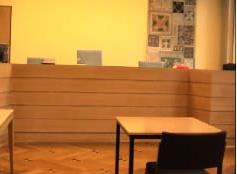
|
|
The courtroom in Kirchhain where anti-Nazi Dr. Brosa was put on 'trial'.
Looking from the front, the accused and defender sit at the table on the left, the
witnesses sit at the table in the middle. On the left of the bench sits the court writer,
the judge in the middle. The prosecutor sits on the bench next to the judge on the
right. (This weird setup is considered to be OK in Germany). |
The trial opened just after 09:00 on 04.11.2004. The relatively early start would normally
have guaranteed a reduced public presence, especially for those who could have been expected
to travel long distances. This well-known tactic failed and there were 8 members of the public
present including a journalist and the author.
Anyone expecting eloquent debate from the middle of the bench or from the prosecutors portion
of it, was headed for a disappointment on that day. Only coarse tones came from that direction
including those of Judge Laudi whose voice sometimes descended into a kind of rasping noise
reminiscent of the "Pop-Eye" films of the 1930s.
At about 09:02 the accused took the stand and was interrogated by Laudi in the nastiest
possible way about his earnings. The StPO of course gives no guidance as to when such sensitive
information should be presented. After a verdict of guilty and if a fine is to be imposed is
the right time in most civilized countries. However German judiciaries always know better and
of course there is the so-called "Vorfahrtsmentalität" the "right of way"
mentality. What is not expressly forbidden, I can do: even if it exposes my own eminent lack
of instinct.
The DA's Office Marburg under the leadership of minor District Attorney Ms Opitz then read
out the full hypocrisy in the charge sheet ( the charge: False accusation ) Of course Opitz
did not attempt to resolve the conflict with Article 17 of the German constitution giving every
German Citizen the right of complaint nor did she check the relevant commentaries "Leipziger
Kommentar, 10. Auflage zu $ 193 StGB Rdn. 22" and "Rudolphi, Horn, Samson, Bd. 2
zu § 193 StGB Rdn. 15 ff". In view of the performances of her department documented
above, she and her assistents might not know to research and make use of these works.
The Complainant is not obliged to deliver evidence, sworn statements from witnesses or forensic
samples. Leaving aside the question of competence for the moment, that is the task of the authorities,
who have the means and the authority to procure such evidence. On the balance of probabilities
and with regard to the compelling weight of the evidence Brosa had been right anyway. It all
boils down to the low level abuse of human rights: The victim can take the human rights violation
to the constitutional court, if he has five years to spare. After all 25,000 judicial murders
of German Citizens in WWII went unpunished in the post-war years, so why should the likes of
Opitz be punished for just a little bending ? That would not be fair.
The muddled process went over into the presentation of evidence. Both Laudi and Opitz's
man forgot to check whether or not Brosa had sent the complaint. whether or not Brosa had signed
the letter allegedly on the 'investigation' file or not. This of course means that Laudi and
Opitz had conducted a process without introducing the main piece of evidence. Even most other
courts in Germany get at least that one right. Outside of Germany this would of course mean
that the charade on 04.11.2004 was about nothing and had, therefore, not been worth 20 cents.
That is a monument particularly to Laudi's amateurishness.
|
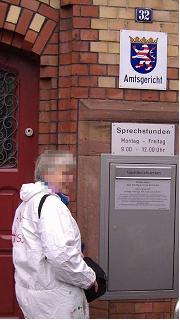
|
|
Witness Irmela Mensah-Schramm in her white overall. (Notice
how the cleverly selected camouflage colors make her invisible to Marburg police lieutenants
when she stands next to buildings.) Called by the defense, Laudi excluded her as a
witness in contravention of the European Convention Art 6-3-d
Photo: www.Projektwerkstatt.de |
After the accused, it was the turn of the two senior policeman in the patrol car to take
the witness stand. Laudi of course thought it to be perfectly feasible that the two 'professionals'
had not been able to find the house. Since the house is only 10 minutes walk from Laudis office,
anything else would have been embarrassing. If Laudi had not seen the house with its symbols
over five years how could you expect two police lieutenants to find it in one afternoon ? There
was a witness who was saying other things of course. Dressed in a snow-white overall Mrs Irmela
Mensah-Schramm had seen the two policemen drive past the house three times, ignoring her signals
to stop. The picture on the left shows her wearing the same overall in front of the court building.
Laudi refused to call this witness. After all witnesses and evidence only serve to confuse
the issue in Laudi's courtroom.
Just as the court was dispersing for the first break at 10:48, a theatre troop unfurled
a backdrop for a mock-TV-program. Laudi immediately jumped in and started shoving and tugging
the participants, presumably trying to pull away the backdrop. He was later joined by the court-orderly
and subsequently by the inspector who had conducted the 'Wolfsangel'-Investigation. The scrum
with Laudi in the middle broke up as it became clear that a member of the public was photographing
the incident and in a kind of "up-and-under" rush pounced on the photographer, wresting
his camera from him. Shortly afterwards Ms Mensah-Schramm stood up to display her white overall
to the public and was attacked by the court orderly, who attempted without success to tear
away the overall. The three incidents took place within the space of about 2 Minutes.
The fact that Laudi as the presiding judge did not try to leave the scene of the incidents
or at least seek refuge behind the bench, but instead took part in the scuffles is another
mark of the quality of the court hearing on that day. Every law student knows why a judge should
try to avoid physical contact during an altercation in the courtroom. The most obvious being
that a judge lying KO would not be able to proceed with the court hearing. Secondly the judge
dressed conspicuously is the one figure most likely to get 'socked', should socking be part
of the act. Thirdly, the dignity and credibility of a court hearing would suffer greatly under
a judge involved in a courtroom scuffle. As it happened, Laudi's courtroom had already lost
its credibility and dignity though its other qualities. Since the three Marburg policeman were
present at the time, Laudi's 'pitching in' may have been a mark of his confidence in the Marburg
police to be able to deal with a scuffle alone. Whatever the ins and outs, Laudi had exposed
himself once again as an eminently incompetent judiciary.
Certainly, it is correct for a judge to discard evidence if he sees no place for it. It
would have been possible to dismiss the two police lieutenants in the patrol car as a stereo
pair of jokers who could not under any circumstances be taken seriously. In that case, the
correct procedure would have been to announce that he was not going to use this evidence and
to inform the prosecutor and defender that he was not going to call Mrs Mensah-Schramm to testify.
A judiciary with nefarious motives on the other hand would not want to put such cards on the
table.
Indeed in Laudi's written judgement he made a big deal of the incident with the patrol car.
In that case his refusal to hear a material witness to the incident had been a serious transgression.
The 'trial' ended with a conviction of the anti-Nazi for false accusation (73 day units
which leads to a registered conviction ). Anyone thinking that such a result could only be
justified with copious amounts of insincerity and verisimilitude is right. A glance at the
performance figures for the Marburg police would be enough to recognize it for what it is.
For that reason, the author has spared himself the task of translating Laudi's junk. The full
text in German is included, however, for downloading as a zip-file.
The Law Professor and the Medical Tribunal
The South Württemberg Medical Council ( Bezirksärztekammer ) is situated in the
town of Reutlingen. Among its tasks this Council holds disciplinary tribunals for charges against
medical doctors in its area of responsibility. The legal procedures are supervised by a professor
of law, so that one should expect a specially high quality of due process.
|

|
|
Professor of Law Dr. Kamps |
A disciplinary process against a medical professor at one of the South Württemberg
clinics in the summer of 2000 produced an astonishing case history which, without the evidence,
would probably be written off as pure fantasy.
A medical professor, head of the pathology department at a large clinic came to the author
in the Summer of 2003 with the documentation of charges against him which had been before the
medical council. The accused is known in this under the pseudonym, "Prof. Miller".
The documentation received by Prof. Miller consisted of twelve A4 pages of closely written
text. This was accompanied by a covering letter bearing the date 07.08.2000, from Professor
of Law Dr. Kamps, the legal advisor and managing director of the council. The documentation,
suitably anomymized is reproduced under:
Documentation ( Prof Kamps)
of 07.08.2000 (html - German)
Download as pdf-File (2.2 MByte
)
This paper covers the violations of Prof. Miller's human rights which are laid
down in the European Convention for human rights. The Convention is largely a collection of
safeguards expressed as procedural articles. For that reason a blow by blow translation of
Prof. Kamps' paper was not considered necessary. Instead the defects in it are analyzed in
the table below.
|
Topic
|
Page(s) |
Remarks |
|
1. Charges:
None stated
|
1-4 |
Neither the covering letter nor the preamble to the court verdict contained any
information as to what charges had been laid against Prof. Miller. The remaining text
also does not make the reader any wiser.
The absence of charges renders Prof Kamps' document completely worthless. The commentary
follows nevertheless, because there are other defects in it.
|
|
2. Evidence:
No understandable evidence offered.
|
4-8 |
The 'evidence' seems to be contained in these pages, which have the side-heading
( reasons ). If indeed reasons were supposed to have been given, then they have been
jumbled up with the narrative. There is little corelation to any piece of documentary
evidence and no cross-references to any file enclosures ( if there is a case file ).
The text degenerates otherwise largely into bewildering "He said, she said"
reporting.
It is not possible to class the content of pages 4-8 as anything other than gossip.
|
|
3. Legal Evaluation:
Without charges a legal evaluation has no useful purpose.
|
8-14 |
How Prof. Kamps and / or his people were able to legally evaluate a process without
any charges is a complete mystery - to anybody but himself perhaps.
These pages seem to consist of randomly selected paragraphs from the regulations,
which supposedly refer to the text in pages 4-8 but cannot be correlated because of
the muddled structure of the paper.
|
|
4. Format:
Paragraph numbering |
4-14 |
The absence of paragraph numbering in such a large document makes it virtually impossible
to read. The handwritten paragraph numbers were inserted by the author in a vain attempt
to make some sense of Prof. Kamps' muddled document.
|
|
5. Format:
List of written Evidence |
None |
There is no list of written evidence making it impossible to determine what weighting
the court had placed on such items. Nor were there any cross references to file enclosures
- if there had been a usable investigation file.
In such cases one would expect to see training schedules and log books as evidence
of the duration and content of the training conducted by the accused. The Medical Council
in Reutlingen has produced no usable regulations to cover the necessary training documentation.
|
|
6. Format:
List of Witnesses |
None |
There is no list of witnesses making it impossible to determine which statements
and more importantly which of the gossiping witnesses the court had taken seriously. |
|
7. Format:
The Constitution of the Tribunal |
None |
There is no indication as to how the 'hearing' which had allegedly taken place on
02.08.2000 had been constituted, except to say that it had been a "board meeting".
This would make it impossible for the accused to test the impartiality or otherwise
of individual members of the tribunal.
|
The letter announced that the disciplinary council had decided to withdraw the
accused's authority to train other medical doctors as a disciplinary measure. Such a measure
represents a particularly damaging attack on the reputation of the pathologist, tantamount
to professional ruination. The covering letter does not indicate what kind of procedure was
used for such drastic decision, stating only that they had considered three letters from colleagues
or pupils of the accused.
Most German judiciaries do not seem to know the difference between narrative, rationale
and deduction - probably that is the reason why they lump everything together under what they
laughingly call "Begründung" or "Gründe" in court verdicts. The
muddle produced by Prof Kamps and his people, however takes this general 'PISA' effect in the
written work of the German Justice System several steps further.
The reputation of a medical doctor is one of his or her most precious and vital assets,
which should only be called into question if there is compelling evidence in prima facie against
him or her. In that case the accused has untouchable rights to a meticulous investigation,
followed by a fair hearing. The medical tribunal here lead by Prof. Kamps made no effort to
fulfil these requirements. Instead it produced an appalling piece of work which in its amateurishness
could not be excelled.
Kamps' trial and punishment of Professor Miller without charges was a gross violation
of Art 6-3-a of the European Convention for Human Rights which accords every accused
person the right to be informed in detail of the charges against him or her. The conduct of
a hearing without revealing its constitution was a gross violation of Art 6-1 of the
Convention, because the accused has no way of testing the impartiality of the board
members.
The Law Professor, Cardinal Santori and The Document
Shredder
|

|
|
Cardinal Giulio Antonio Santori ( 1532 - 1602). Grand Inquisitor.
"Knowest Thou, why Thou art here ?" |
The procedures adopted by Professor Dr. Kamps against Prof. Miller are not unknown
in European History: The Grand Inquisitor Cardinal Santori ( 1532 - 1602 ) would arraign
the accused person and open the proceedings with the question "Knowest Thou, why Thou
art here ?". This very effective opening gambit, similar to some of the techniques used
by the KGB during the Cold War, brought results for Santori, because the accused would somehow
end up accusing himself - Santori knew how to engineer that. Whilst by contrast no one would
want to accuse Prof Kamps of being systematic, Santori was not only the Vatican's most successful
inquisitor, he was also a meticulous and industrious bureaucrat. His perfectly kept records
can be seen today in the archives of the Vatican.
Professor Kamps, on the other hand, operates a very different archiving concept:
Dr. Rudolf Seuffer, a clinical pathologist and civil rights activist, together with his attorney
found that out with a vengeance. As Seuffer wanted to gain access to a process file containing
a discredited complaint against himself by a colleague, he inquired about the procedure for
doing so on 06.02.2000. According to the advice received, Seuffer tasked his attorney to formally
apply for access to the file on 19.04.2000. The medical council replied on 02.10.200 stating
that the file has been destroyed between the first inquiry and the formal application. An investigation
by the Data Protection Authority of the state of Baden-Württemvberg found in its report
of the 14.12.2000 that the council had acted incorrectly in destroying the file after the first
inquiry. Seuffer submitted criminal charges against Kamps and his medical court attorn ( Kammeranwalt
) on 17.12.2000. The DA's office in Tübingen could, however, not proceed against Kamps
because the new more stringent data protection laws had come into force about a month after
the offences had been committed.
Human Rights Abuses on Display
in Courtroom Soaps
|

|

|
|
Judiciary Salesch |
Judiciary Hold |
|
"sausaging ( fudging) through" with two television
judiciaries |
The "Strafprozessordnung" ( StPO) which is supposed to be the equivalent of rules
of procedure ( RPs ) is a product of the thoroughness of German Judiciaries over decades and
as such is completely unusable for the purpose of standardizing any form of orderly court hearing.
Court hearings in Germany run on the principle "Durchwurschteln", literally "sausaging
through" and that just about sums up the procedures on display in the television courtroom
series "Richterin Barabra Salesch" and "Richter Alexander Hold" ( SAT 1
Afternoon Programs: A parabolic dish may be needed for reception ( Astra Footprint). ).
The programs reflect perfectly the kind of bedlam which rules in German courtrooms: Right
from the word go the accused takes the stand and gets interrogated about his or her earnings
and other sensitive social data, very often in the nastiest possible way. The StPO of course
gives no guidance as to when such sensitive information should be presented. After a verdict
of guilty and if a fine is to be imposed is the right time in most civilized countries. This
procedure also not only offends against the European Convention for Human Rights,
by treating the accused differently to other witnesses, it also offends against Germany's data
protection laws: If a verdict of not guilty is reached, then social data will have unnecessarily
been made public, for which the offending judge can himself be prosecuted. However German judiciaries
always know better and of course there is the so-called "Vorfahrtsmentalität"
the "right of way" mentality. What is not expressly forbidden in the StPO I can do
- even if it exposes my own eminent lack of instinct.
Witnesses do not get properly briefed on their obligations not to discuss the case with
others before being heard. Very often a witness, already heard is told to remain on call -
and sit in the courtroom. Strange variations of musical chairs infrequently get played out
with witnesses being circulated between stand and public gallery.
Courtroom discipline is severely lacking. Witnesses are allowed to bellow at one another
which would offend against the Convention Article 6 ( a hearing at all ), if the accused happens
to have a speech defect or a sore throat. ( In civil law you need a good loud voice in Germany,
otherwise your claims are likely to get lost in the acoustics. )
The principles of the chain of custody and introduction of evidence are unknown entities
in Germany. Inadequately certified items are the rule and not the exception. Sometimes Barbara
Salesch seems to be pulling items from under the bench or even out of her handbag. The necessary
formalities of donor and recipient are foreign languages here. There are also no such things
as "laws of discovery". Ambush prosecution and ambush defence are a way of life.
The program does not of course show the representative quality of the court documentation
or the condition of the process files. That needs to be seen to be believed in real life. You
can get some idea from the section "Dr. Brosa and the 'Modersohn Alternatives' in Marburg
" above. These shocking reports together with the TV program sections are all indications
as to what extent German Judiciaries set themselves appallingly low standards - which they
consistently fail to achieve.
Human Rights: Germany "outs"
itself in Karlsruhe
The Decision of the Supreme Court of the Constitution 14.10.2004
 The Supreme Court of the Constitution
decided on 14.10.2004 that the decisions of the European Court of Human Rights EUCHR were not
binding on German Courts. A translation in English was posted on the Web-site of the Court
under:
The Supreme Court of the Constitution
decided on 14.10.2004 that the decisions of the European Court of Human Rights EUCHR were not
binding on German Courts. A translation in English was posted on the Web-site of the Court
under:
http://www.bverfg.de/entscheidungen/rs20041014_2bvr148104.html
The meaningful Passage in the Judgement
The passage under check mark 17 - which was accurately translated - is interesting:
|
"As a result of the status of the European Convention on Human Rights as
ordinary statutory law below the level of the constitution, the ECHR was not functionally
a higher-ranking court in relation to the courts of the States parties. For this reason,
neither in interpreting the European Convention on Human Rights nor in interpreting
national fundamental rights could domestic courts be bound by the decisions of the
ECHR." |
The Court is saying effectively that European Law is subordinate to German Law ( in Germany
presumably ) and that German courts can please themselves as to whether they adhere to the
decisions of the EUCHR or not.
What the Convention on Human Rights says
The European Convention on Human rights was signed by Germany on 4.11.1950. Article 46 makes
abundantly clear that the decisions of the EUHCR are binding.
|
Article 46 - Binding force and execution of judgments
|
|
1. The High Contracting Parties undertake to abide by the final judgment of the
Court in any case to which they are parties.
|
The decision by the Supreme Court of the Constitution of 14.110.2004 was according
to Article 46, therefore, a gross violation of the convention.
What the Treaty of Maastricht says
|
The Treaty of Maastricht, TITLE I COMMON PROVISIONS Article 6-2
|
|
The Union shall respect fundamental rights, as guaranteed by the European Convention
for the Protection of Human Rights and Fundamental Freedoms signed in Rome on 4 November
1950 and as they result from the constitutional traditions common to the Member States,
as general principles of Community law. |
Through violation of the European Convention for the Protection of Human Rights and Fundamental
Freedoms the Federal Republic of Germany has, therefore, also violated the Treaty of Maastricht.
Concluding Remarks
Sanctions
The decision by the Supreme Court of the Constitution was effectively a tangible "Outing"
of Germany's long standing but well-camouflaged contempt for and violations of human rights.
This enables German NGOs to make the point without long arguments.
Germany's violation of the European Convention for Human Rights and Basic Freedoms as well
as the treaty of Maastricht make it unsuitable for continued full membership of the EU. In
particular Germany should not be allowed to represent the EU in foreign policy or especially
in international committees where human rights are at issue. Possibly the model proposed by
the parliamentary opposition ( CDU/CSU ) for Turkey, i.e. privileged partnership instead of
full membership may be of interest. Whatever really is suitable in the end, at least swingeing
sanctions against Germany for its live abuses of human rights is long overdue.
The EU-Commission has been asked to report Germany to the OSCE with a view to expelling it
from the Council of Europe, because membership in this body is tied to the observance of the
European Convention for Human Rights and the decisions of the EUCHR.
01.11.2004
Peter Briody
"institut voigt"
 There is ample evidence
of systematic human rights abuses having been perpetrated in West Germany ( now the re-unified
Federal Republic ) during the post-war occupation and thereafter. This went largely unnoticed
even by the western powers, mainly because the abuses were surreptitious and well camouflaged,
kept at low level, "under the radar" of the watch organizations.
There is ample evidence
of systematic human rights abuses having been perpetrated in West Germany ( now the re-unified
Federal Republic ) during the post-war occupation and thereafter. This went largely unnoticed
even by the western powers, mainly because the abuses were surreptitious and well camouflaged,
kept at low level, "under the radar" of the watch organizations. 












 The Supreme Court of the Constitution
decided on 14.10.2004 that the decisions of the European Court of Human Rights EUCHR were not
binding on German Courts. A translation in English was posted on the Web-site of the Court
under:
The Supreme Court of the Constitution
decided on 14.10.2004 that the decisions of the European Court of Human Rights EUCHR were not
binding on German Courts. A translation in English was posted on the Web-site of the Court
under: